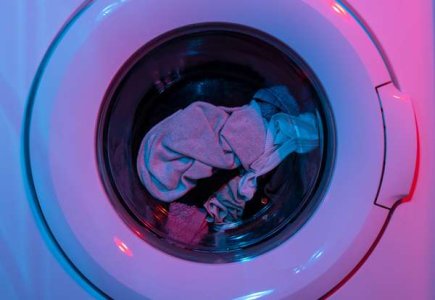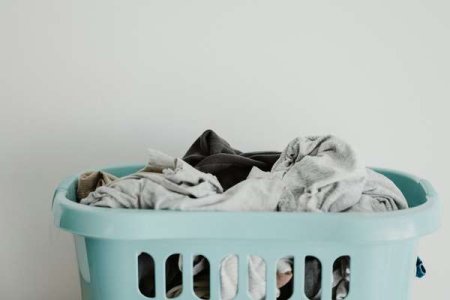Are you exposing yourself to deadly pathogens? Shocking warning about this common home appliance
- Replies 0
If you’re like most Americans, you probably toss your laundry in the washing machine, add a scoop of detergent, and trust that your clothes will come out fresh, clean, and—most importantly—germ-free.
But what if we told you that your trusty washing machine might not be doing the job you think it is?
Recent scientific research has uncovered a hidden danger lurking in millions of homes, and it’s something every household—especially those with healthcare workers—needs to know.
The Surprising Truth About Your Washing Machine
A new study led by microbiologists at the UK’s De Montfort University has sent shockwaves through the medical and scientific communities.
Their findings? Up to half of home washing machines fail to kill dangerous, treatment-resistant pathogens—even when washing at high temperatures and with strong detergents.
For the 22 million Americans working in healthcare, and their families, this could mean that deadly bacteria are hitching a ride from the hospital right into your home.
But it’s not just healthcare workers who should be concerned. These antibiotic-resistant bacteria can survive in the nooks and crannies of your washing machine, potentially contaminating every load of laundry—sheets, towels, and even your favorite sweater.

What Did the Scientists Discover?
The research team put six popular models of home washing machines to the test, using fabric swatches contaminated with a particularly nasty bug: Enterococcus faecium.
This bacteria is notorious for causing everything from skin infections to life-threatening illnesses like meningitis and heart infections, especially in vulnerable people.
Here’s what they found:
- Rapid Wash Cycles: Half of the machines failed to disinfect the contaminated swatches.
- Standard Wash Cycles: One-third still didn’t get the job done.
- Temperature Trouble: None of the machines actually reached the recommended 140°F (the temperature needed to kill most pathogens). Most hovered between 134°F and 136°F, and one never got above 68°F!
- Detergent Dilemma: Both biological (enzyme-based) and non-biological detergents were tested, but neither guaranteed complete disinfection.
Also read: The surprising truth about how long you can really leave wet clothes in the washer—find out now!
Even more alarming, the researchers discovered that some bacteria not only survived the wash but also became more resistant to both detergents and antibiotics over time.
That means your washing machine could be helping to breed superbugs.
The Hidden World Inside Your Washer
It gets worse. When the scientists swabbed the insides of 12 different washing machines, they found a veritable zoo of bacteria, including:
- Acinetobacter (linked to pneumonia and wound infections)
- Pseudomonas (can infect lungs, blood, and skin)
- Mycobacterium (responsible for tuberculosis and leprosy)
Many of these bacteria carried genes that make them resistant to antibiotics, and they were found lurking in the biofilm—the slimy residue that builds up inside your machine over time.

Why Should You Care?
Hospital-acquired infections are a major public health concern, often involving bacteria that are tough to treat and can be deadly. If healthcare workers’ uniforms aren’t properly disinfected, these pathogens can spread to their families and communities.
But even if you don’t work in healthcare, your washing machine could still be harboring bacteria that cause skin infections, respiratory illnesses, and more.
Older adults, young children, and anyone with a weakened immune system are especially at risk.
What Can You Do to Protect Yourself?
Don’t panic—there are steps you can take to make your laundry routine safer and your home healthier:
1. Crank Up the Heat
- Whenever possible, wash items—especially those exposed to germs—at the highest temperature recommended by the fabric care label. Aim for at least 140°F for towels, bedding, and uniforms.
2. Use Bleach or Disinfectant Additives
- For whites and colorfast items, add a disinfecting laundry bleach. For colored items, look for laundry sanitizers that are safe for your fabrics.
3. Don’t Overload the Machine
- Give your clothes room to move so water and detergent can reach every fiber.
4. Clean Your Washing Machine Regularly
- Run an empty hot wash with bleach or a washing machine cleaner at least once a month. Pay special attention to the detergent drawer, door seals, and any removable parts.
5. Dry Thoroughly
- High heat in the dryer can help kill lingering germs. If you air-dry, make sure items are completely dry before folding and storing.
6. Separate High-Risk Laundry
- If someone in your household works in healthcare or is ill, wash their uniforms and linens separately from other laundry.
7. Follow Hospital Guidelines
- If you’re a healthcare worker, check if your employer offers on-site laundering. If not, ask about best practices for home laundering, and consider advocating for safer options.
Read next: Are detergent pods a ticking time bomb in your home? Expert reveals shocking truth!

Have you ever worried about germs in your laundry? Do you have tips for keeping your washing machine clean? Share your thoughts and experiences in the comments below!
But what if we told you that your trusty washing machine might not be doing the job you think it is?
Recent scientific research has uncovered a hidden danger lurking in millions of homes, and it’s something every household—especially those with healthcare workers—needs to know.
The Surprising Truth About Your Washing Machine
A new study led by microbiologists at the UK’s De Montfort University has sent shockwaves through the medical and scientific communities.
Their findings? Up to half of home washing machines fail to kill dangerous, treatment-resistant pathogens—even when washing at high temperatures and with strong detergents.
For the 22 million Americans working in healthcare, and their families, this could mean that deadly bacteria are hitching a ride from the hospital right into your home.
But it’s not just healthcare workers who should be concerned. These antibiotic-resistant bacteria can survive in the nooks and crannies of your washing machine, potentially contaminating every load of laundry—sheets, towels, and even your favorite sweater.

Scientists have found that domestic washing machines often fail to properly disinfect healthcare uniforms, allowing dangerous, treatment-resistant pathogens to survive. Image source: Engin Akyurt / Unsplash.
What Did the Scientists Discover?
The research team put six popular models of home washing machines to the test, using fabric swatches contaminated with a particularly nasty bug: Enterococcus faecium.
This bacteria is notorious for causing everything from skin infections to life-threatening illnesses like meningitis and heart infections, especially in vulnerable people.
Here’s what they found:
- Rapid Wash Cycles: Half of the machines failed to disinfect the contaminated swatches.
- Standard Wash Cycles: One-third still didn’t get the job done.
- Temperature Trouble: None of the machines actually reached the recommended 140°F (the temperature needed to kill most pathogens). Most hovered between 134°F and 136°F, and one never got above 68°F!
- Detergent Dilemma: Both biological (enzyme-based) and non-biological detergents were tested, but neither guaranteed complete disinfection.
Also read: The surprising truth about how long you can really leave wet clothes in the washer—find out now!
Even more alarming, the researchers discovered that some bacteria not only survived the wash but also became more resistant to both detergents and antibiotics over time.
That means your washing machine could be helping to breed superbugs.
The Hidden World Inside Your Washer
It gets worse. When the scientists swabbed the insides of 12 different washing machines, they found a veritable zoo of bacteria, including:
- Acinetobacter (linked to pneumonia and wound infections)
- Pseudomonas (can infect lungs, blood, and skin)
- Mycobacterium (responsible for tuberculosis and leprosy)
Many of these bacteria carried genes that make them resistant to antibiotics, and they were found lurking in the biofilm—the slimy residue that builds up inside your machine over time.

The study revealed that up to half of household washing machines do not decontaminate uniforms during a rapid cycle, and a third fail to do so even with a standard cycle. Image source: Annie Spratt / Unsplash.
Why Should You Care?
Hospital-acquired infections are a major public health concern, often involving bacteria that are tough to treat and can be deadly. If healthcare workers’ uniforms aren’t properly disinfected, these pathogens can spread to their families and communities.
But even if you don’t work in healthcare, your washing machine could still be harboring bacteria that cause skin infections, respiratory illnesses, and more.
Older adults, young children, and anyone with a weakened immune system are especially at risk.
What Can You Do to Protect Yourself?
Don’t panic—there are steps you can take to make your laundry routine safer and your home healthier:
1. Crank Up the Heat
- Whenever possible, wash items—especially those exposed to germs—at the highest temperature recommended by the fabric care label. Aim for at least 140°F for towels, bedding, and uniforms.
2. Use Bleach or Disinfectant Additives
- For whites and colorfast items, add a disinfecting laundry bleach. For colored items, look for laundry sanitizers that are safe for your fabrics.
3. Don’t Overload the Machine
- Give your clothes room to move so water and detergent can reach every fiber.
4. Clean Your Washing Machine Regularly
- Run an empty hot wash with bleach or a washing machine cleaner at least once a month. Pay special attention to the detergent drawer, door seals, and any removable parts.
5. Dry Thoroughly
- High heat in the dryer can help kill lingering germs. If you air-dry, make sure items are completely dry before folding and storing.
6. Separate High-Risk Laundry
- If someone in your household works in healthcare or is ill, wash their uniforms and linens separately from other laundry.
7. Follow Hospital Guidelines
- If you’re a healthcare worker, check if your employer offers on-site laundering. If not, ask about best practices for home laundering, and consider advocating for safer options.
Read next: Are detergent pods a ticking time bomb in your home? Expert reveals shocking truth!
Key Takeaways
- Scientists have found that domestic washing machines often fail to properly disinfect healthcare uniforms, allowing dangerous, treatment-resistant pathogens to survive.
- The study revealed that up to half of household washing machines do not decontaminate uniforms during a rapid cycle, and a third fail to do so even with a standard cycle.
- Harmful, antibiotic-resistant bacteria and bacterial residue were discovered lingering inside washing machines, along with genes that increase resistance to antibiotics and detergent.
- Researchers recommend that laundering guidelines be updated, and that hospitals provide on-site industrial washers for staff to help reduce the spread of infections and antimicrobial resistance.
Have you ever worried about germs in your laundry? Do you have tips for keeping your washing machine clean? Share your thoughts and experiences in the comments below!






